Another cute mate from an Internet blitz game I played today.

Another cute mate from an Internet blitz game I played today.

Managed to amuse myself by finishing a blitz game with a knight journey ending in mate.
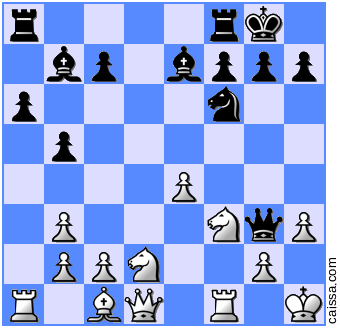
Some uncharacteristic chess heroism:

Black has just played Nf6-d7 thinking he has enough time to force an exchange of my bishop on e5. Think again!
16. Bxg7 Rfd8 (…Kxg7? 17. Nh5+ Kh8 18. Qh6 and mate on h7 or g7 next move) 17. Nh5 e5
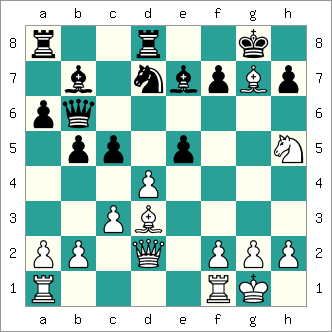
18. Bxh7+ Kapow! I think this is the first time I’ve done this kind of double bishop sacrifice with justification. 18… Kxh7 19. Nf6+ Qxf6 (…Kxg7 20. Qg5+ and mate next move, or …Bxf6 or …Nxf6 20. Qh6+ and mate next move) 20. Bxf6 Bxf6
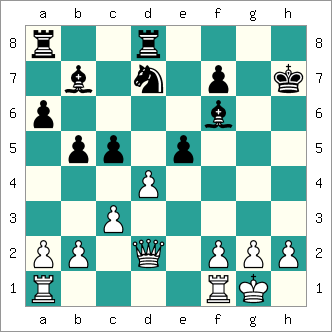
and white should be winning.
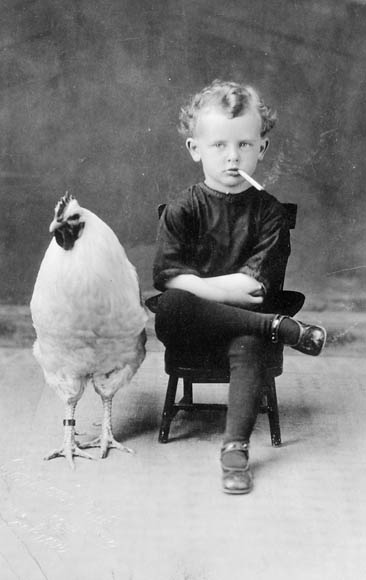
This is from a game I just played. White has an open h-file to attack black’s king, but there’s a crushing quiet move for black who has the move. What is it?
I was actually saving that title for my cultural studies (yes, this really exists) thesis but the cover of the newly released Deep Fritz 11 (a computer chess program) was just too evocative for me:
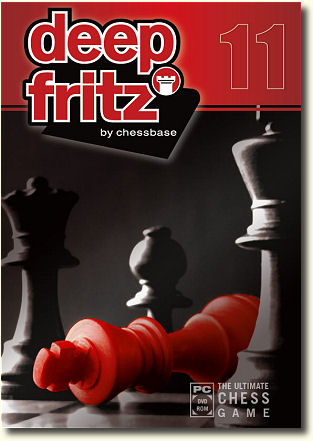
Is it just me or is this a gang rape?
Ample evidence of [Short’s lack of subtlety] is on the record, not the least of which was his response to a question posed by a French journalist that “France represents everything I detest most in life. Your country’s only useful products are porn films.”
In addition, and as many other Grandmasters seem to, Short has a tendency to describe this apparently (to us patzers) docile, if cerebral, game in largely sexual language. And it’s rough sex Nigel seems to be looking for.
Dominic Lawson’s book The Inner Game has the slight, rather imp-ish Short quoted as saying about a particular opponent: “I’m going to give it to him good and hard. I’m going to give the guy a good rogering. I’m going to give it to him good and hard, right up him. I want to rape and mate him.” Tyson language in spectacles.
Lawson also reports that in Barcelona in 1987 he first heard Short use the acronym TDF, which he imagined to be a contraction of some arcane chess strategy. Short and the American Grandmaster Yasser Seirawan kept using the expression while poring over a board and discussing tactics. Finally Lawson asked them what it meant. In unison, and with evident pleasure, they growled back:
“Trap. Dominate. Fuck.”
The longest forced mate (assuming black tries to postpone mate as far as possible) currently known: 524 moves. Nobody knows what the first 500 mean. As Tim Krabbé says of these computer wins, it’s like discovering the secret to the universe but it’s in Estonian.
Of the recently finished Chess World Championship my favourite moment came in game 10, the only one Kramnik won. In this position:
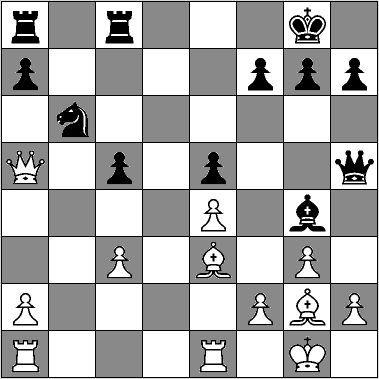
It would be nice to be able to make creeping moves in life as well, but in general it’s just too complicated. People can decide not to play by the rules you expect them to. Perhaps this sort of thing can happen in politics or war.
Today I saw Woody Allen’s new film Vicky Cristina Barcelona which partly made me think of this. The first quarter or so of the film contains some excellent portrayals of the psychological views of PUAs (Pick-Up Artists), presumably unintentionally. I don’t know does Javier Bardem’s character exactly make creeping moves, but he certainly leaves practically no choice to the women he seduces.
The film also has a somewhat bleak but potentionally educational view of American women, or possibly women in general (it was difficult to tell). There may certainly be an interesting lesson in the film on that theme for some people amongst my readership. Overall I must say I don’t understand why the cultured anglosphere of The Guardian and NYT seems to have turned its back on Allen. They say he’s just a boring, creepy, ogling old man now but I suspect they’re just jealous.
I have just finished what is presumably the last Swedish exam of my life (unless I flunked it), so I’m going to celebrate by boring you with chess.
Some time ago I heard that an (Internet) chess acquaintance of mine had fallen badly ill and was possibly dying (he didn’t die and is all right now (update years later: he did die, of the same illness)). I tried to think of something nice to send him and came up with selecting four chess positions I considered beautiful for whatever reason, made a little poster of them and mailed it along with a brief letter. I don’t know how that was supposed to help, but the positions are still nice.

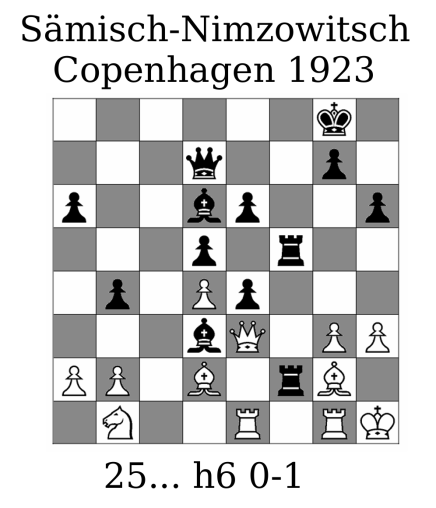
The point of black’s last move, 25… h6, is that it quietly points out to white that he now has no move that won’t lose him material. There are a couple of pawns he can still push, but once black blocks those with his own pawns, white will have to move a piece and lose material (or get mated) and thus lose the game.

This is from the second Karpov-Kasparov World Championship match. The previous one was supposed to be played until one of the players won six games, but Kasparov, down 2-5, just refused to lose any more and in fact started to look unstoppable in the last couple of games. FIDE (the international chess federation) controversially aborted the match which had overlasted all previous ones (48 games, 41 of them drawn) and exhausted everyone, and declared a new one to be played the next year.
In that match it became obvious that Kasparov had grown considerably as a player, and won convincingly. This game was probably his finest effort. Kasparov was considered to be a mercurial, tactical player compared to the clear, cool and positional Karpov, but in this game he puts Karpov into an impossible bind quite early on. There are a number of positions I could have chosen from that game, but this one shows Kasparov’s dominance nicely: the black “octopus” knight on d6 rules the back rank and has the white rooks utterly stuck, the white queen has no safe moves, and in general white just has no play whatsoever. On move 22. And Karpov is playing white. This was inconceivable at the time, and legendary to this day.
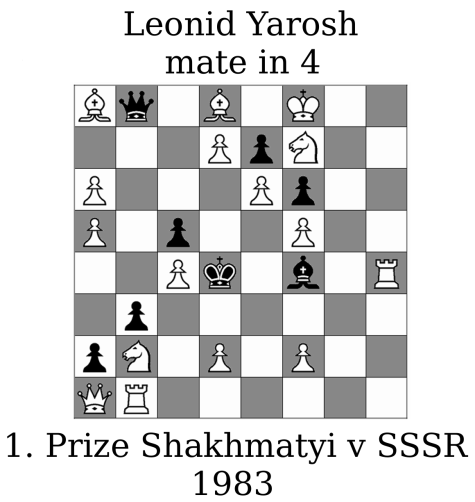
This is the first realisation of the Babson task, a very famous chess problem theme. Any number of people dedicated themselves to finding a Babson problem, but none did, and the theme had even fallen out of fashion because it came to be considered impossible. Then in the eighties a Soviet soccer coach named Leonid Yarosh found one – and soon after that, he found another one. Some others have discovered alternate constructions inspired by this, but the Yarosh ones remain the most famous. If you don’t want to be (partially) spoiled regarding the solution, don’t read the next paragraph. Unless you already knew what the Babson task is and I already spoiled it for you.
The Babson task is this: construct a mate problem (white to mate in a fixed number of moves against any defence) such that if black defends by promoting to a queen, white can only make the required mate by promoting to a queen; if black promotes to a rook, white has to promote to a rook also – and the same with bishop and knight. If you have any experience of chess, you’ll know that this sounds impossibly difficult. I won’t spoil the whole solution of this problem, but it’s quite findable on the net.